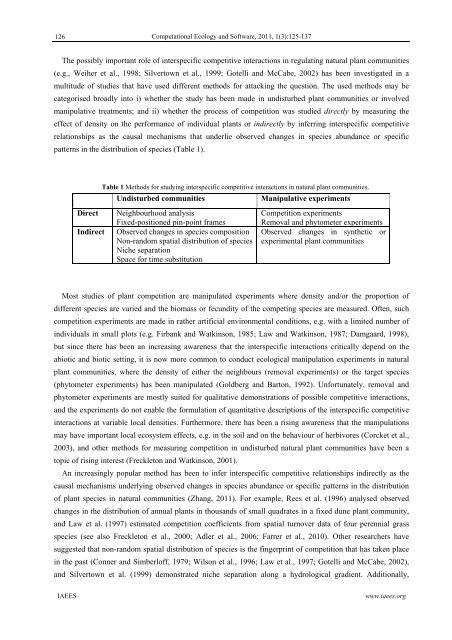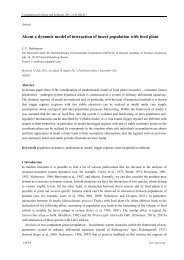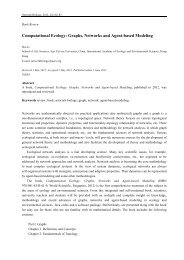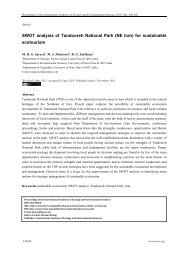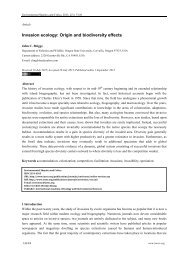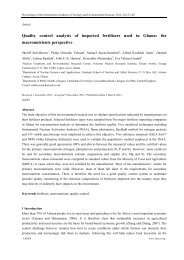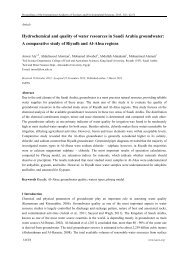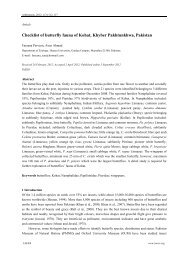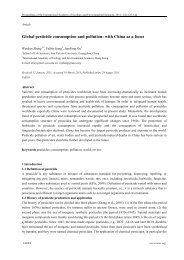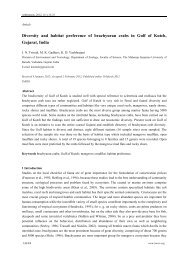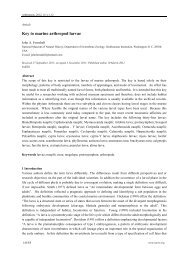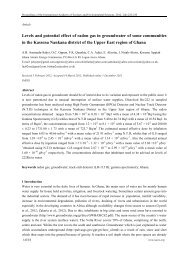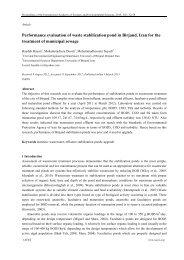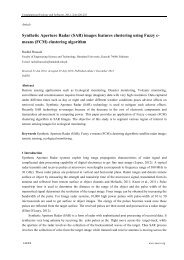Measuring competition in plant communities where it is difficult to ...
Measuring competition in plant communities where it is difficult to ...
Measuring competition in plant communities where it is difficult to ...
Create successful ePaper yourself
Turn your PDF publications into a flip-book with our unique Google optimized e-Paper software.
126<br />
Computational Ecology and Software, 2011, 1(3):125-137<br />
The possibly important role of <strong>in</strong>terspecific compet<strong>it</strong>ive <strong>in</strong>teractions <strong>in</strong> regulat<strong>in</strong>g natural <strong>plant</strong> <strong>commun<strong>it</strong>ies</strong><br />
(e.g., Weiher et al., 1998; Silver<strong>to</strong>wn et al., 1999; Gotelli and McCabe, 2002) has been <strong>in</strong>vestigated <strong>in</strong> a<br />
mult<strong>it</strong>ude of studies that have used different methods for attack<strong>in</strong>g the question. The used methods may be<br />
categor<strong>is</strong>ed broadly <strong>in</strong><strong>to</strong> i) whether the study has been made <strong>in</strong> und<strong>is</strong>turbed <strong>plant</strong> <strong>commun<strong>it</strong>ies</strong> or <strong>in</strong>volved<br />
manipulative treatments; and ii) whether the process of <strong>compet<strong>it</strong>ion</strong> was studied directly by measur<strong>in</strong>g the<br />
effect of dens<strong>it</strong>y on the performance of <strong>in</strong>dividual <strong>plant</strong>s or <strong>in</strong>directly by <strong>in</strong>ferr<strong>in</strong>g <strong>in</strong>terspecific compet<strong>it</strong>ive<br />
relationships as the causal mechan<strong>is</strong>ms that underlie observed changes <strong>in</strong> species abundance or specific<br />
patterns <strong>in</strong> the d<strong>is</strong>tribution of species (Table 1).<br />
Direct<br />
Indirect<br />
Table 1 Methods for study<strong>in</strong>g <strong>in</strong>terspecific compet<strong>it</strong>ive <strong>in</strong>teractions <strong>in</strong> natural <strong>plant</strong> <strong>commun<strong>it</strong>ies</strong>.<br />
Und<strong>is</strong>turbed <strong>commun<strong>it</strong>ies</strong><br />
Manipulative experiments<br />
Neighbourhood analys<strong>is</strong><br />
Fixed-pos<strong>it</strong>ioned p<strong>in</strong>-po<strong>in</strong>t frames<br />
Observed changes <strong>in</strong> species compos<strong>it</strong>ion<br />
Non-random spatial d<strong>is</strong>tribution of species<br />
Niche separation<br />
Space for time subst<strong>it</strong>ution<br />
Compet<strong>it</strong>ion experiments<br />
Removal and phy<strong>to</strong>meter experiments<br />
Observed changes <strong>in</strong> synthetic or<br />
experimental <strong>plant</strong> <strong>commun<strong>it</strong>ies</strong><br />
Most studies of <strong>plant</strong> <strong>compet<strong>it</strong>ion</strong> are manipulated experiments <strong>where</strong> dens<strong>it</strong>y and/or the proportion of<br />
different species are varied and the biomass or fecund<strong>it</strong>y of the compet<strong>in</strong>g species are measured. Often, such<br />
<strong>compet<strong>it</strong>ion</strong> experiments are made <strong>in</strong> rather artificial environmental cond<strong>it</strong>ions, e.g. w<strong>it</strong>h a lim<strong>it</strong>ed number of<br />
<strong>in</strong>dividuals <strong>in</strong> small plots (e.g. Firbank and Watk<strong>in</strong>son, 1985; Law and Watk<strong>in</strong>son, 1987; Damgaard, 1998),<br />
but s<strong>in</strong>ce there has been an <strong>in</strong>creas<strong>in</strong>g awareness that the <strong>in</strong>terspecific <strong>in</strong>teractions cr<strong>it</strong>ically depend on the<br />
abiotic and biotic sett<strong>in</strong>g, <strong>it</strong> <strong>is</strong> now more common <strong>to</strong> conduct ecological manipulation experiments <strong>in</strong> natural<br />
<strong>plant</strong> <strong>commun<strong>it</strong>ies</strong>, <strong>where</strong> the dens<strong>it</strong>y of e<strong>it</strong>her the neighbours (removal experiments) or the target species<br />
(phy<strong>to</strong>meter experiments) has been manipulated (Goldberg and Bar<strong>to</strong>n, 1992). Unfortunately, removal and<br />
phy<strong>to</strong>meter experiments are mostly su<strong>it</strong>ed for qual<strong>it</strong>ative demonstrations of possible compet<strong>it</strong>ive <strong>in</strong>teractions,<br />
and the experiments do not enable the formulation of quant<strong>it</strong>ative descriptions of the <strong>in</strong>terspecific compet<strong>it</strong>ive<br />
<strong>in</strong>teractions at variable local dens<strong>it</strong>ies. Furthermore, there has been a r<strong>is</strong><strong>in</strong>g awareness that the manipulations<br />
may have important local ecosystem effects, e.g. <strong>in</strong> the soil and on the behaviour of herbivores (Corcket et al.,<br />
2003), and other methods for measur<strong>in</strong>g <strong>compet<strong>it</strong>ion</strong> <strong>in</strong> und<strong>is</strong>turbed natural <strong>plant</strong> <strong>commun<strong>it</strong>ies</strong> have been a<br />
<strong>to</strong>pic of r<strong>is</strong><strong>in</strong>g <strong>in</strong>terest (Freckle<strong>to</strong>n and Watk<strong>in</strong>son, 2001).<br />
An <strong>in</strong>creas<strong>in</strong>gly popular method has been <strong>to</strong> <strong>in</strong>fer <strong>in</strong>terspecific compet<strong>it</strong>ive relationships <strong>in</strong>directly as the<br />
causal mechan<strong>is</strong>ms underly<strong>in</strong>g observed changes <strong>in</strong> species abundance or specific patterns <strong>in</strong> the d<strong>is</strong>tribution<br />
of <strong>plant</strong> species <strong>in</strong> natural <strong>commun<strong>it</strong>ies</strong> (Zhang, 2011). For example, Rees et al. (1996) analysed observed<br />
changes <strong>in</strong> the d<strong>is</strong>tribution of annual <strong>plant</strong>s <strong>in</strong> thousands of small quadrates <strong>in</strong> a fixed dune <strong>plant</strong> commun<strong>it</strong>y,<br />
and Law et al. (1997) estimated <strong>compet<strong>it</strong>ion</strong> coefficients from spatial turnover data of four perennial grass<br />
species (see also Freckle<strong>to</strong>n et al., 2000; Adler et al., 2006; Farrer et al., 2010). Other researchers have<br />
suggested that non-random spatial d<strong>is</strong>tribution of species <strong>is</strong> the f<strong>in</strong>gerpr<strong>in</strong>t of <strong>compet<strong>it</strong>ion</strong> that has taken place<br />
<strong>in</strong> the past (Conner and Simberloff, 1979; Wilson et al., 1996; Law et al., 1997; Gotelli and McCabe, 2002),<br />
and Silver<strong>to</strong>wn et al. (1999) demonstrated niche separation along a hydrological gradient. Add<strong>it</strong>ionally,<br />
IAEES<br />
www.iaees.org


